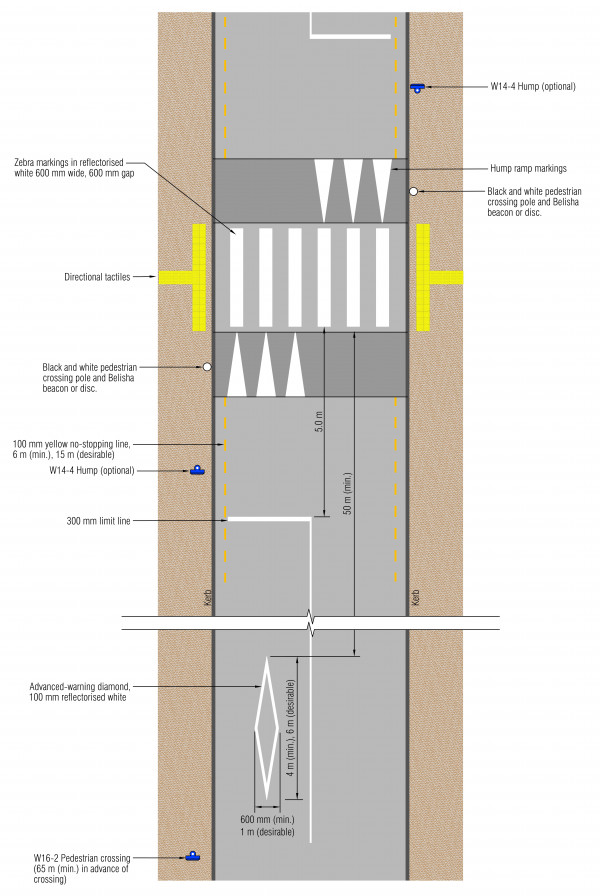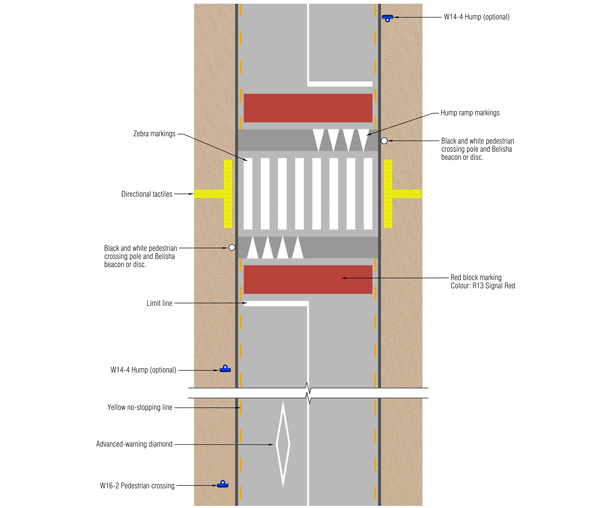A raised zebra crossing (also called a zebra crossing on a raised platform) incorporates a priority crossing featuring white striped bars on a platform raised above the road carriageway.
An example of a raised zebra crossing is shown in the photo below.

Retrofit raised zebra crossing, Blenheim. (Photo: Peter Kortegast)
Check whether a raised zebra crossing is a suitable treatment for your site by referring to
PNG: Crossing selection process
Raised zebra crossings can be combined with other elements including
PNG: Pedestrian / median refuges
The legal considerations are the same as for
Although raised zebra crossings may be legally up to 15m long, none should be longer than 10m. Where a longer distance is likely, kerb extensions should be used to reduce the distance travelled in one crossing movement.
If kerb extensions cannot be used, pedestrian refuges may be installed instead, noting this legally divides the crossing into two stages which can be problematic in terms of vehicles giving way.
PNG: Pedestrian / median refuges
Cyclists using a zebra crossing should take care when crossing, given that the Road User Rule does not specifically require drivers to give way to cyclists riding across a zebra crossing. Riders may therefore prefer to dismount and walk their bicycle across the roadway. If significant numbers of cyclists are expected to use the zebra crossing, then a dual crossing should be installed.
Cycling Network Guidance: Dual crossings
On-road cycle lanes or separated cycleways across zebra crossings require careful treatment. Refer to Cycle lanes at pedestrian crossings for more information.
TCD Manual Part 5: Cycle lanes at pedestrian crossings
A typical layout of a raised zebra crossing is shown below.

Typical layout for pedestrian crossing (zebra) on raised platform. (Source: TCD Manual Part 5 Figure 7-11
The tables below outline the markings, signs and other design elements for raised zebra crossings. These are similar to flush zebra crossings with some additions. Further detail on the traffic control device elements is provided in:
TCD Manual Part 5 – Pedestrian crossings (zebra)
Table: Marking requirements for raised zebra crossings
| Element |
Requirement |
Additional information |
|
Crossing bars |
Bar width = 600mm |
The bars should be marked parallel to the direction of approaching traffic and so as to provide the most convenient route for pedestrians. |
|
Centre-line |
A centre-line should be marked. |
A centre-line should be marked if there is not one. The centre-line should stop short of the crossing point at the limit line. |
|
Limit lines |
300mm minimum limit lines are required. |
Located 5m in advance of the crossing bars. |
|
No-stopping lines |
No-stopping lines should be marked. |
No-stopping lines should be marked not more than 1m out from the kerb or edge of seal and for a minimum distance of 6m prior to the crossing bars. This distance should be increased to 15m where operating speeds are greater than 30km/h. |
|
Advance warning diamond |
Diamond symbol is good practice but optional |
If marked, the diamond should be at least 50m in advance of the crossing bars. There may be situations where installation of an advance warning diamond would conflict with other markings or be confusing to road users. In these situations, the diamond should be omitted. |
|
Hump ramp markings |
Hump ramp markings should be marked on the face of the vertical deflection device visible to approaching drivers (ie. the ramp of a raised zebra). The markings consist of evenly spaced white triangles . |
Dimensions and spacing of hump ramp markings are provided in |
Sufficient contrast must be provided between the crossing bars and the roadway. Therefore use of paving, such as shown in the photo below, or red or pink colouring between the white bars does not provide sufficient contrast.

Paved zebra crossing providing insufficient contrast of white bars. (Photo: Jeanette Ward)
Table: Signage requirements for raised zebra crossings
| Element |
Requirement |
Additional information |
|
W16-2 Pedestrian crossing |
Must be installed in advance of all marked pedestrian crossings. |
Installation as per Table 7-6 of: |
|
W16-3 Belisha beacon disc or Belisha beacon on black and white poles |
Belisha beacon disc or a Belisha beacon installed on black and white poles located within 2m of each end of the zebra crossing. |
|
|
W14-4 Hump |
Vertical alignment hump sign may be used to warn drivers that the zebra crossing is on a raised platform. |
If used, the sign should be located adjacent to the hump or no more than 20m in advance of it to ensure the sign does not obscure the Belisha discs/beacon for approaching drivers. It should be located where approaching drivers have an uninterrupted view of it over a distance of at least 60m. |
Table: Other design elements and considerations for raised zebra crossings
| Element |
Requirement |
Additional information |
|
Platform height |
100mm recommended. |
75mm may be considered where site constraints and traffic composition suggest a lower height profile is suitable (ie high truck volume routes). 150mm may be considered for low speed and low traffic volume environments. |
|
Platform length |
Minimum length 2m, maximum length 6m. |
|
|
Approach ramp gradient |
At least 1:15 for 30km/h platform speed, steeper ramps are more effective in slowing vehicle speeds. |
1:20 for 40km/h platform speed or 1:25 for 50km/h platform. Ramp grade should be designed to achieve the required Safe System impact speed prior to entering the conflict point. Steeper ramp gradients may be appropriate for lower operating speeds. |
|
Departure ramp gradient |
Maximum 1:35 |
Where the raised zebra crossing is located on an undivided carriageway, the departure ramp gradient will be the same as the approach ramp gradient. |
|
Tactile indicators |
Warning indicators are required and directional indicators may be necessary |
|
|
Lighting |
Crossings must be illuminated at night. If the RCA is of the opinion that the crossing will not be used at night it must still be illuminated by street lighting. |
Lighting for zebra crossings should meet the requirements of AS/NZS 1158.4: 2015 Lighting of pedestrian crossings(external link) |
|
Use of red surfacing treatment |
Red surfacing treatment is optional. A recommended approach to highlight zebra crossings whilst ensuring that sufficient contrast is provided between the crossing bars and roadway is the use of red surfacing on the vehicle approaches to the zebra crossing. |
Further guidance on the appropriate red surfacing treatment is provided below. |
Some RCAs highlight the presence of a zebra crossing to drivers and riders using coloured surfacing. However, the use of red surfacing should only be used, or approved, by an RCA in a manner that compliments and enhances regulatory markings and signs.
When installing red surfacing it is important that sufficient contrast is provided between the crossing bars and the roadway for all road users. Visually impaired road users have reported that red and pink colouring between the white bars does not provide adequate contrast. Red coloured surfacing is permitted under the Land Transport Rule (Traffic Control Devices) provided it is not part of or visually integrated into an official road marking. Refer to the Roadway art guidance for further information.
Draft Handbook for Tactical Urbanism in Aotearoa - Roadway Art guidance
The result of this is that it is not recommended practice to apply red coloured surfacing immediately beneath the zebra crossing bar markings.
A recommended approach that meets the needs of all road users and aligns with the above legislation is to apply areas of red coloured surfacing on the vehicle approaches as shown in the figure below for a raised zebra crossing with dimensions outlined in the following table.

Typical layout for raised zebra crossing with red surfacing treatment.
The recommended colour for red is R13 Signal Red, as set out in the P33 specifications with the layout dimensions outlined in the table below. The red surfacing must not encroach onto the no-stopping lines.
P33 Specification for coloured pavement surfacings
Table: Red surfacing treatment dimensions for raised zebra crossings
| Marking |
Dimension |
|
Typical length of red surfacing |
2.0m |
|
Minimum gap between red surfacing and limit line |
0.5m |
|
Minimum gap between red surfacing and hump ramp markings |
0.5m |
Note that the dimensions of red surfacing treatments at zebra crossings that are flush with the roadway are different.
[1] Corben, B. (2020). Integrating Safe System with Movement and Place for Vulnerable Road Users(external link), Austroads, AP-R611-20, p19